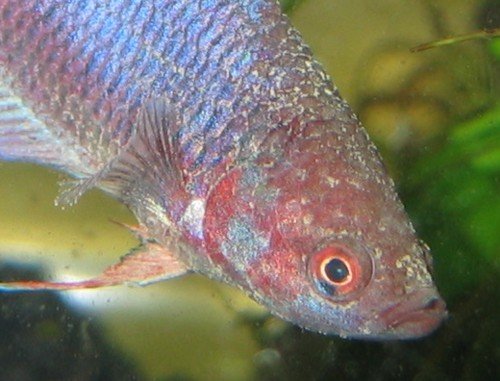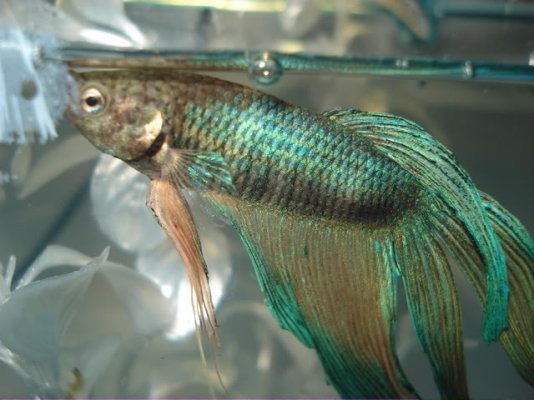Sluggish Betta: Please help!!
I have had my male betta for two and a half years. When I first got him, he was very lively, always swimming, etc. For the past two and a half years, he was kept in a one gallon tank (please don't think I'm a terrible betta owner). -.- I always did weekly water changes, fed him betta pellets every other day, and he seemed happy. For the past few weeks, he has started acting very sluggish and strange. He started just laying at the bottom of the tank, sometimes on his side and slightly curled up. He would only come up for air, and occasionally for food, but would sink back down to the bottom, tail first. He seemed excited about food, no matter the circumstance, but he wouldn't always eat it. I thought maybe it was swim bladder, so I tried the "fasting for a few days them feeding the cooked pea" thing, but he wanted nothing to do with the pea.
I started thinking maybe the ammonia levels were high, or that he was cold, so I went out and bought a ten gallon aquarium with a filter and a heater, and if it matters, some little caves and a new plant. I rinsed out the tank and thoroughly rinsed all of the decorations and marbles, and did everything as instructed. I set up the tank, heater and filter, let it run for 24 hours, then slowly acclimated him to the new tank. Once he was in the tank, he seemed interested, but still hung out on the bottom. He slowly made his way around the tank and stopped in the caves frequently and just layed there.
It's been a few days now since he's been in the tank, and I know they take time to adjust, but he's just acting the same. I thought the heat might perk him up a bit, but he's still laying there most of the time. He's not even interested in food anymore (he used to come to the surface when I shook his food container in front of the tank). He just looks at it and won't move. I added a few corydoras, which he doesn't seem to mind. The tank temp is at a constant 78-80 degrees F, and the filter is running on one side of the tank. I tested the ammonia, which was at zero.
Could he still be adjusting to the new tank or could there be something else wrong with him? His fins, scales and coloring still look healthy; he's still his usual bright red. Could he just be getting old? Please help. I love this fish to death, and I don't want to lose him if there's something I can do to help.
I have had my male betta for two and a half years. When I first got him, he was very lively, always swimming, etc. For the past two and a half years, he was kept in a one gallon tank (please don't think I'm a terrible betta owner). -.- I always did weekly water changes, fed him betta pellets every other day, and he seemed happy. For the past few weeks, he has started acting very sluggish and strange. He started just laying at the bottom of the tank, sometimes on his side and slightly curled up. He would only come up for air, and occasionally for food, but would sink back down to the bottom, tail first. He seemed excited about food, no matter the circumstance, but he wouldn't always eat it. I thought maybe it was swim bladder, so I tried the "fasting for a few days them feeding the cooked pea" thing, but he wanted nothing to do with the pea.
I started thinking maybe the ammonia levels were high, or that he was cold, so I went out and bought a ten gallon aquarium with a filter and a heater, and if it matters, some little caves and a new plant. I rinsed out the tank and thoroughly rinsed all of the decorations and marbles, and did everything as instructed. I set up the tank, heater and filter, let it run for 24 hours, then slowly acclimated him to the new tank. Once he was in the tank, he seemed interested, but still hung out on the bottom. He slowly made his way around the tank and stopped in the caves frequently and just layed there.
It's been a few days now since he's been in the tank, and I know they take time to adjust, but he's just acting the same. I thought the heat might perk him up a bit, but he's still laying there most of the time. He's not even interested in food anymore (he used to come to the surface when I shook his food container in front of the tank). He just looks at it and won't move. I added a few corydoras, which he doesn't seem to mind. The tank temp is at a constant 78-80 degrees F, and the filter is running on one side of the tank. I tested the ammonia, which was at zero.
Could he still be adjusting to the new tank or could there be something else wrong with him? His fins, scales and coloring still look healthy; he's still his usual bright red. Could he just be getting old? Please help. I love this fish to death, and I don't want to lose him if there's something I can do to help.


